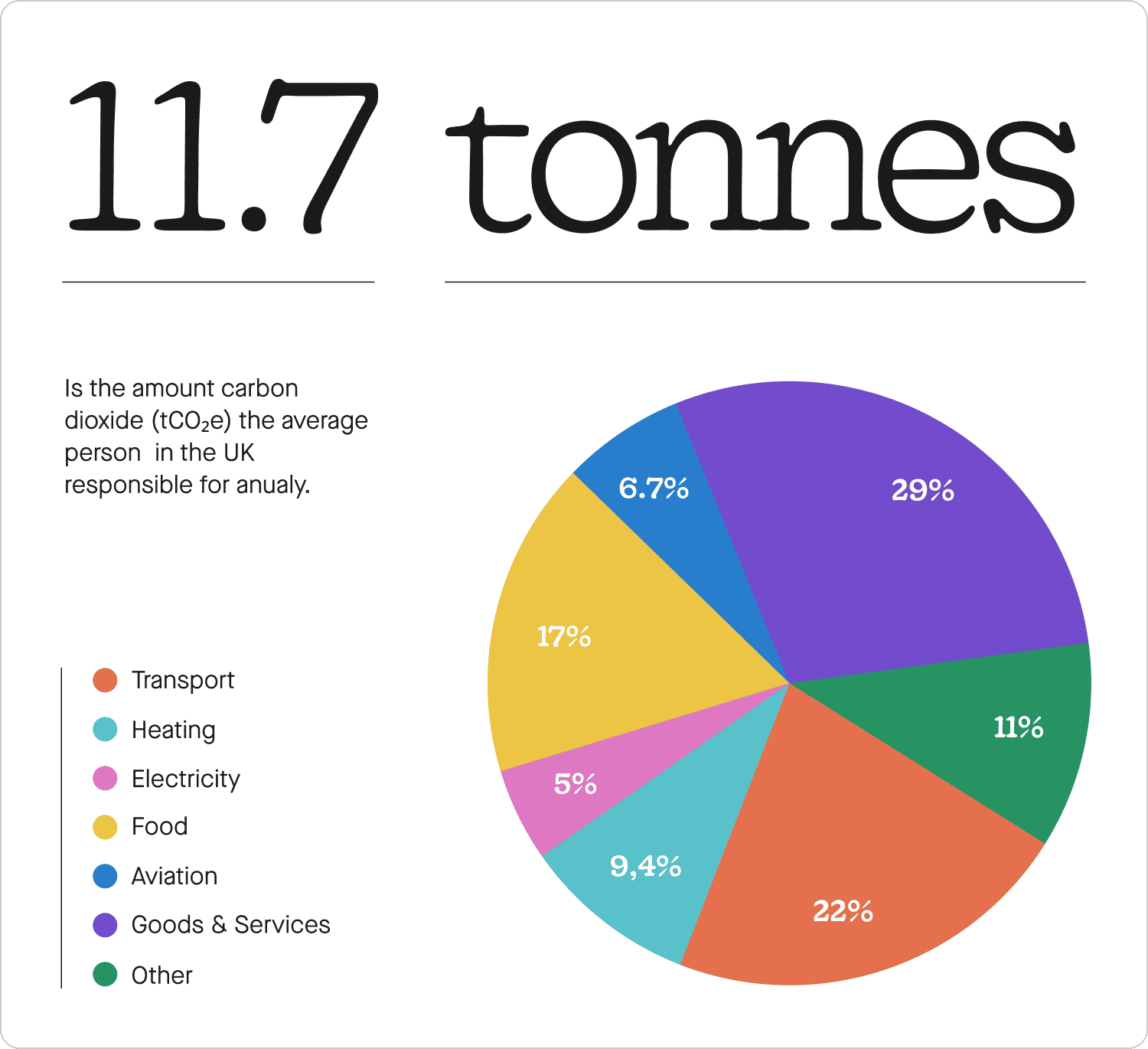Curious about the UK’s carbon footprint? We’re diving into the freshest stats, tracking how things have evolved, and spotlighting what’s next as we race towards those crucial net-zero goals!
What is a Carbon Footprint?
A carbon footprint refers to the total greenhouse gas emissions caused directly and indirectly by an individual, organisation, product, or country.
These are measured in tonnes of carbon dioxide equivalent (tCO₂e), which includes not only CO₂ but also methane, nitrous oxide, and other warming gases.
You might also see the term “consumption-based emissions” - this includes emissions from goods and services consumed in the UK, even if they were produced abroad.
Average Carbon Footprint in the UK (Per Person)
According to the latest government data, the average UK resident is responsible for around 11.7 tonnes of CO₂e per year (DEFRA, 2022). This includes both:
Direct emissions (like heating your home or driving)
Indirect emissions (such as imported goods, food, and services)
That total is based on the UK’s national consumption-based emissions of 740.1 million tonnes CO₂e, divided across a population of 63.3 million.
This number is based on consumption-based emissions, which account for the carbon embedded in goods we import and consume, even if they were produced overseas.
How does this compare historically?
Since 1990, the UK’s per-person carbon emissions have fallen significantly. Households have reduced their emissions by an estimated 4.7 tonnes per year since 1990.
That said, emissions reductions have slowed in recent years, especially in areas like home heating and transport.
Carbon Footprint Breakdown (Per Person)
Here’s where the UK’s emissions come from on a per-person basis:

Image created and owned by Heatable. All rights reserved. Data sourced from DEFRA, CCC, DESNZ, and other official UK government publications.
Note on “Other”:
“Other” includes emissions not directly tied to individual consumption, such as industrial processes, refrigerant gases (e.g. HFCs), defence operations, public sector activity, and upstream supply chain emissions. These are grouped into “unattributed sectors” in DEFRA’s consumption-based model, as they support society broadly but can’t be easily assigned to specific consumers.
It’s not just about how we heat our homes or drive - what we eat and buy contributes more to our carbon footprint than many people realise. From fast fashion and electronics to meat-heavy diets and international flights, our choices add up.
What About Households?
While individual footprints are useful for personal comparison, household figures still matter.
The average UK household (2.3–2.4 people) is responsible for around 26–28 tonnes of CO₂e annually, depending on energy use, consumption habits, and lifestyle.
In 2014, the government estimated household emissions at 8.1 tonnes per home, but this figure didn’t fully reflect consumption-based emissions. More recent estimates give a clearer, fuller picture.
What is the Fifth Carbon Budget?
The Fifth Carbon Budget, released in 2015 by the Climate Change Committee (CCC), sets out legally binding targets for reducing the UK’s emissions between 2028 and 2032.
It states that by 2030:
UK emissions must be 57% below 1990 levels
Household emissions should fall to around 4.5 tonnes per year
This means a further reduction of 3.7 tonnes per home on average
These targets form part of the UK’s legally binding commitment to reach net zero by 2050.
How Will These Carbon Reductions Be Made?
Here’s how UK households are expected to help meet the 2030 goals:
1. Home Heating
Around 87% of UK homes still rely on gas boilers
The CCC recommends that 1 in 7 homes switch to a low-carbon heating system by 2030
Options include heat pumps, hybrid systems, and heat networks
For example:
1 in 20 gas-heated homes joining a heat network could save 2 tonnes of CO₂e per year
Switching from oil to a heat pump could save 3.2 tonnes
Switching from electric heating to a heat pump could save 0.8 tonnes
2. Electricity Generation
The UK grid is still partially powered by fossil fuels
Average electricity use per home is around 3,700 kWh/year
At 2022’s grid carbon intensity of 0.162 kg CO₂e/kWh, that’s around 0.6 tCO₂e per person
As more renewables (like wind and solar) come online, electricity-related emissions could drop by 79%, saving homes up to 1.25 tonnes annually
Related guides:
3. Transport & Travel
Cars, trains, and domestic flights account for 2.6 tonnes per person
Switching to more efficient petrol or diesel cars can save 0.9 tonnes per household
Fully electric vehicles (EVs) can save up to 2 tonnes per year
The CCC suggests 1 in 6 homes should be using an EV by 2030
4. Food & Consumption
Food accounts for 2.0 tonnes per person
Lowering meat consumption and reducing food waste can make a big impact
Reducing fast fashion, electronics, and other high-emission purchases can also cut up to 3.4 tonnes
5. Waste & Recycling
Household waste generates 0.3 tonnes per person
Improving recycling and cutting down on landfill/incineration can save 0.25 tonnes
These changes can also reduce methane emissions and benefit local councils financially
6. Digital & Devices
The digital footprint of a UK resident is 0.1 tonnes/year, including internet use, data centres, and device production
While small, this number is growing, and choosing energy-efficient devices and longer-lasting tech can help
Bonus Benefit: Home Efficiency
Improving insulation, upgrading windows, and using smart heating systems can:
Save 0.6 tonnes of CO₂e annually
Cut energy bills by up to £184 per year in gas-heated homes
Final Thoughts
From 1990 to today, the UK has made serious progress in cutting carbon emissions. But there’s still a long way to go - especially at the household level.
Whether it’s eating differently, travelling cleaner, or switching your heating system, your personal and household choices can be a big part of the UK’s net-zero future.





